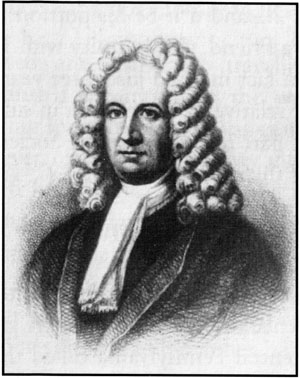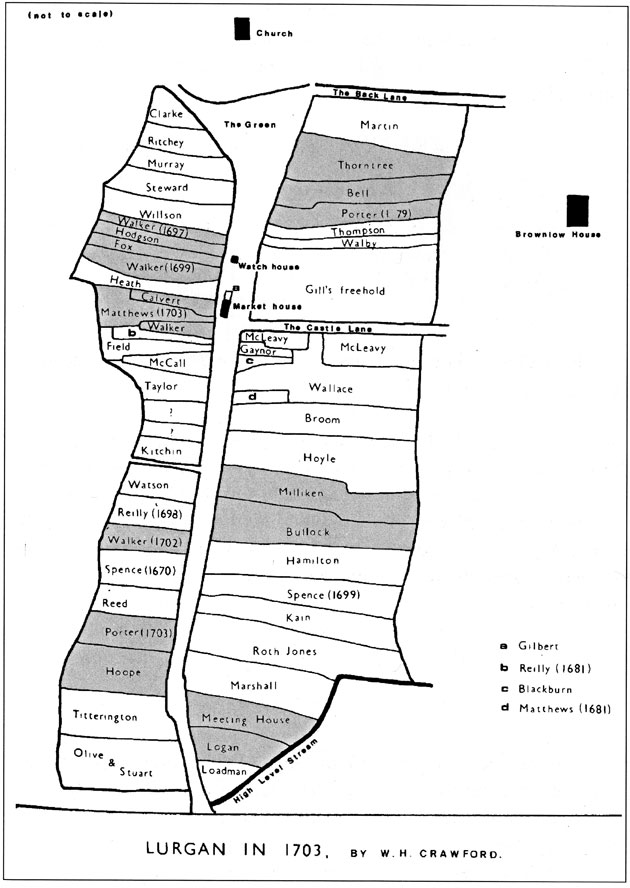History of The Religious Society of Friends in Lurgan
CHAPTER THREE
EMIGRATION
The founding
of Pennsylvania by William Penn in 1681 proved to be a great attraction to
Friends in all parts of Ireland, especially because of the harassment over
tithes and oaths, the unsettled political state of the country and the deteriorating
economic conditions. Many were drawn by the prospect of religious freedom
and the challenge offered by the development of this new and vast territory.
Between the years of 1682 and 1750 a total of 440 adults are recorded as leaving
Friends meetings in Ireland. More Friends emigrated from County Armagh than
from any other county in Ireland and Lurgan meeting was well represented throughout
that period.
VALENTINE HOLLINGSWORTH
The first
Lurgan Friend to venture to the New World was probably Valentine Hollingsworth.
His family had settled in the district early in the 16th century, for Valentine
was born in 1632 in Ballymacrandle in the parish of Seagoe. On Lynastown deeds
he is descrihed as a 'freeholder' and appears to have owned the entire townland.
In 1682 he
travelled from Belfast to the Delaware area together with his wife and several
children, his son-in-law Thomas Conway and an indentured servant, Thomas Musgrave.
He settled not far from the present city of Wilmington on an estate of nearly
1000 acres. He was an influential man in the new colony, for he was appointed
a Justice of the Peace and represented New Castle County in the Pennsylvania
Assembly at various times from 1685 until 1700. He donated a plot of land
for use as a burial ground for Friends and meetings were held in his home
in the early days before a permanent meeting house was built.

HENRY HOLLINGSWORTH
His son Henry
followed one year later, travelling as one of seventeen 'redemptioners' or
indentured servants with the wealthy Dublin merchant, Robert Turner. After
serving for two years he was granted fifty acres in his own right. His thoughts,
however, often went back over the seas to Lurgan to the girl he had loved
before he left for America and in 1688 he made the long journey back to Ireland.
He was married to Lydia Atkinson in the house of John Robson in June 1688.
One can imagine the excitement which his arrival caused and the questions
he was asked about what life was like in the faraway world of Pennsylvania.
Shortly after his wedding he returned with Lydia to America and became surveyor
of a county area. Like his father he became a member of the Provincial Assembly.
His uncle
John Calvert and family settled in the same area of Pennsylvania as did another
Lurgan family called Dixon.
GEORGE AND MICHAEL HARLAND
The Lurgan
connection was strengthened further by the arrival of the Harland brothers,
George and Michael, in 1687. George brought his wife and young family and
Michael, who was unmarried, found a wife in the new settlement shortly after
his arrival. She was Dinah Dixon, originally from Lurgan, who was living in
the same area. George soon became one of the foremost citizens of the colony
and was a member of the Colonial Assembly. Friends Meetings for Worship were
often held in his home before a permanent building was erected. The Harlans,
as they spelt their name after removal to America, became a widely connected
and eminent family in the USA. A detailed genealogical record has been produced
and a family reunion in 1987 (to mark the 300th anniversary of their arrival
in America) brought together a vast assembly of descendants from almost every
state of the USA. It is interesting to note that one descendant married a
son of Abraham Lincoln and another was the wife of President McKinley.
ALPHONSUS KIRK
In 1688 another
member of an important Lurgan family sailed from Belfast bound for the same
region. Alphonsus Kirk of Tullygally, aged twenty-nine, brought with him a
certificate of removal from Lurgan Meeting with a postscript from his parents
stating "we are willing our son above named should take this journey
herein mentioned ......and if it be his portion to marry we do give our consent,
provided it be to a Friend, and in unity with Friends, according to the order
of truth.". He was in fact married just three years later to another
Ulster Friend emigrant and other relatives followed him in subsequent years.
The Kirk family played a significant part in the life of the Society of Friends
in America and in the development of the country.
MENALLEN TOWNSHIP
Emigrants
to a strange and undeveloped country often brought the name of their former
place of residence to their new abode. A group of Ulster emigrants who found
their way to central Pennsylvania called their settlement Menallen after the
district (Moyallon) which they had left. The Friends Meeting there contained
a high proportion of members of Ulster origin with names such as Christy,
Hewitt, and Hobson prominent. It remains an important Friends centre in that
part of Pennsylvania and provides a clear witness to the contribution of the
early Irish pioneers.
WILLIAM PENN IN LURGAN
William Penn,
himself, had important associations with Ireland, chiefly on account of his
estates in Munster and often spent time in the south of the country. He paid
an extensive religious visit to Ireland in 1698 in the course of which he
engaged in disputations on doctrine with various church leaders and sought
to improve the circumstances of Friends by representations to government officials.
His biographer, Clarkson, records Lurgan among the places he visited and
states: 'at
all of which places he preached to large assemblies, and with great advantage
to the character of his own Society, but particularly in the latter place
(i.e. Lurgan), because many professors among the Sectarians who atttended
him acknowledged that the Quakers had been wronged by false reports concerning
their principles and doctrines.' He must have been keen to include Lurgan
in his itinerary, as he would have been aware of its importance as a Quaker
settlement through the many emigrants who had already made their mark in the
province of Pennsylvania.


JAMES LOGAN
The most
important Lurgan man in the development of Pennsylvania was James Logan, born
in the town in 1674. His father, Patrick Logan, was born in Scotland, studied
at Edinburgh University and became a clergyman of the Established Church.
He later became a Quaker, resigned his position and moved to Lurgan where
he took charge of a Latin school. His son James was born and grew up in a
house near the site of the old Meeting House in High Street. At the age of
13 James was apprenticed to a Dublin linen merchant, Edward Webb, but because
of the unsettled state of the country, he rejoined his family in Lurgan after
a stay of only six months and they all returned soon after to Scotland.
In 1690 the
Logans moved from Scotland to Bristol where Patrick was appointed master of
a Friends' School. Three years later he and the family returned to Lurgan,
leaving James at the age of nineteen in charge of the school. James was a
successful schoolmaster, but he longed for a wider scope for his talents and
so he engaged in business enterprises in Bristol, involving shipping between
that city and Dublin. William Penn, who had been a governor of the Bristol
school, recognised James Logan's abilities and took him with him in 1699 to
America as his secretary. During the next forty years Logan held high public
office, being in effect Governor of Pennsylvania during the absences of the
Proprietor and his son. At various times he acted as Mayor of Philadelphia
and Chief Judge of the Supreme Court.
He was constantly
devoted to the interests of the Penn family and the ideals which had prompted
the foundation of the colony. He was a skilled negotiator •with the
Indians and highly respected by them. In his latter years he devoted much
time to scholarly activities and amassed a considerable library, thus showing
a love of learning acquired at the Latin school in Lurgan.
GEORGE HODGSON
While many
emigrants found prosperity and success in the New World there were also sad
cases of hardship, privation and death in the course of the journey or in
the harsh conditions on the American frontiers. One pathetic story is of Robert
Hodgson who emigrated from Lurgan with his wife and family in 1710. The entire
family died on the voyage to America except one son, George, then aged nine.
He was adopted by a Quaker family in Pennsylvania and later married and settled
in North Carolina. A descendant, James D. Rodman, who is also descended from
George Harland, kindly supplied the information.
THOMAS CHILD
Correspondence
to and from emigrants was difficult and contact between families often erratic.
Irish relatives even in those days had high expectations of fortunes being
made in the New World and hopes of financial windfalls were high.
Thomas
Child was a young man who emigrated on his own and settled in Pennsylvania
near other Ulster Friends. Following his death a Lurgan Friend, William Porter,
had written on behalf of Thomas Child's mother, obviously to find out about
his estate. The following reply from George Harlan explains the circumstances
of his death and gives details of the will of which the Harlans were chief
beneficiaries.
Brandywine
Creek
ye 27th of ye 10th month 1696
Loving Friend
William Porter,
This may
acquaint thee that I have received four letters from thee all of one date
and tenor being ye 20th of ye 9th m. '95 in relation to Mary Child whose son
Thomas died something more than two years since at Vallentine Hollingsworths,
he happening to fall sick there and as to what is reported concerning his
bequest to his mother I have here sent thee a copy of his will on the other
side.
I was with
him in time of his sickness and he being about to make his will I put him
in mind of his relations in Ireland and his answer was thus: He had never
received any letter since he had been in the country from any of them, replying
further he had been troublesome to his friends in his life time and questioning
by reason of wars and mortality that had been of late in Ireland who of his
relations might be living or dead.
And to impose
so troublesome an undertaking upon his friends (as the making sale of what
he had and turning it into money and conveying the same to Ireland might prove)
he would not do it.
Thus far
concerning the Child matter. So hoping this may find thee in good health with
thy family, mine with my wife's dear love is remembered unto thee and to the
rest of our friends and relations. Let my brother understand that we are all
indifferent well and know of no alteration since I wrote by Thomas Musgrave.
My wife's dear love is remembered in particular to Robert Hoope and Elenor;
having often desired to hear from them, so having naught else at present but
remain thy friend.

Emigration
was a recurring pattern for Lurgan Friends over the years. Cycles of crop
failures with resultant famines, high rents for small, scarcely economic holdings,
over-population in the North Armagh area, all these factors induced members
at various times to consider the prospects elsewhere. America was always a
favoured destination, but in later years Australia and New Zealand provided
strong incentives and, of course, England and Scotland, where the break with
home did not seem so permanent.

|

